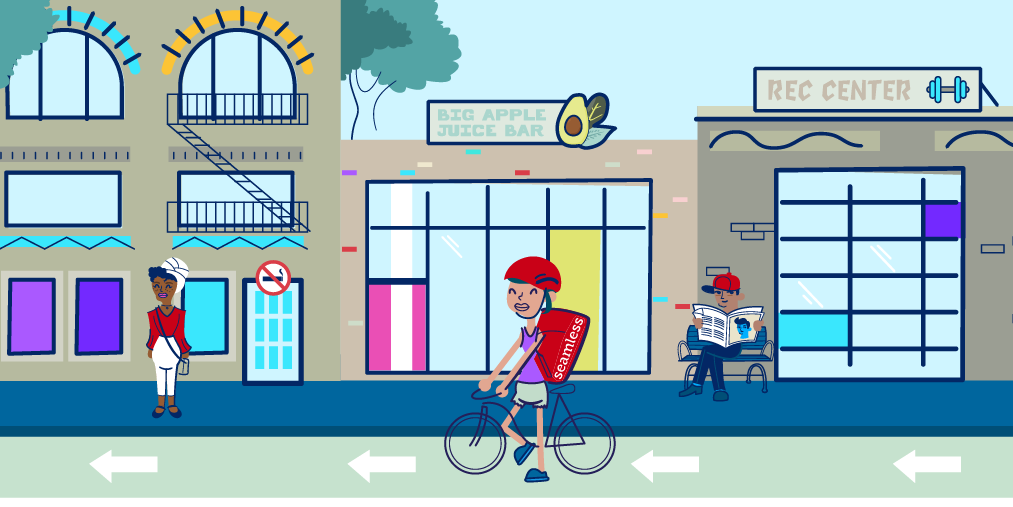
According to U.S. News & World Report, 80 percent of all Americans will ditch their New Year’s resolutions by the second week of February. But one good way to maintain those health-focused goals is to live in a neighborhood with amenities that encourage a healthy lifestyle. While New York City is one of the most bikeable and walkable cities in the world, not all neighborhoods are equal when it comes to healthiness. To figure out which neighborhoods are the healthiest, we partnered with our friends at Seamless and dug into the data.
We analyzed neighborhoods based on a number of factors: 1) The share of apartments in buildings with bike rooms, gyms and smoke-free policies on StreetEasy; 2) the number of restaurants that fulfilled the highest amount of healthy food orders on Seamless; 3) the number of gyms, fitness studios, pools, doctor’s offices, and health and wellness facilities on Yelp; and 4) the number of bike lanes, public parks, community gardens, recreation centers, sports fields, nature areas and farmer’s markets, as found via NYC Open Data.
Combining all of these factors into our Healthiest Neighborhoods Index, we give you the 10 healthiest places to live in New York City:
Finding Healthy Options in Every Borough
New Yorkers looking to live in a neighborhood that encourages a healthy lifestyle will find great options in the outer boroughs. The top four neighborhoods on the list are in Brooklyn or Queens. Across both boroughs, New Yorkers can find ample park space, bike lanes, and healthy food and living options.
While typically thought of as an industrial neighborhood, Red Hook tops our list with the most public park space per capita of any of the neighborhoods on the list, and the second-highest number of bike lanes per capita in the whole city — second only to Port Morris in the Bronx.
Foods linked to brain power, like salmon, and leafy greens, like spinach, are ordered via Seamless from restaurants in Red Hook at a rate higher than the NYC average. Restaurants in the area also receive twice the orders for brown rice as for white rice.
How much will you pay to live the healthy Red Hook lifestyle? The median asking rent in Red Hook is $2,735 — slightly higher than the Brooklyn-wide median of $2,500. But with all of the park space, affordable recreation centers, bike lanes, and apartment buildings offering bike storage rooms, residents are free to break a sweat at little-to-no cost.
The Heart of Manhattan Is Ideal for Fitness Fanatics and Healthy Eaters
Midtown is a great option for health nuts with more than two gyms for every 1,000 residents, plus 38 apartment buildings with fitness centers. On top of endless of indoor workout options, Midtown is also situated directly south of Central Park, one of the biggest outdoor expanses in the city, which offers invaluable mental health benefits.
It’s no surprise that neighborhoods with so many fitness options also tend to be home to restaurants fulfilling nutritious meal orders. Restaurants in Midtown received orders with healthy instructions such as “side salad instead of fries” or “hamburger without the bun” at a rate 40 percent higher than the city average.
Flatiron and Midtown are home to the highest number of health and medical centers per capita on our list. Whether you’re looking for holistic healing or an urgent care facility, these dense Manhattan neighborhoods offer tons of options.
All of these health-related community amenities do come at a cost: the Manhattan neighborhoods on our list are some of the most expensive in the city. Rents in Flatiron and Midtown sit well above the Manhattan-wide median asking rent of $3,195. For neighborhoods with more affordable living options that still offer plenty of health-focused amenities, Oakland Gardens in Queens is No. 4 on our list, while Mott Haven in the Bronx is No. 10. These neighborhoods offer apartments with median asking rents of $1,813 and $2,000, respectively — some of the lowest prices in all of New York City.
How We Did It
Since New York City’s population density varies so much among the five boroughs, we calculated the data in our Healthiest Neighborhoods Index on a per-capita basis to make sure we weren’t giving an undue advantage to any neighborhood because of its population. We also excluded any area with less than 3,000 residents, along with a handful of neighborhoods where data was limited.
We then normalized all of the data to make our index components directly comparable with one another. We ranked neighborhoods against other neighborhoods in their own borough to try to avoid any unfair comparisons. For example, Pelham Bay Park is three times the size of Central Park, so it would be difficult for any Manhattan neighborhood to compete directly with the Bronx on park square footage alone. Similarly, Manhattan has a lot of large residential buildings with fitness centers onsite, while other boroughs have far fewer.
—
Hey, why not like StreetEasy on Facebook and follow @streeteasy on Instagram?